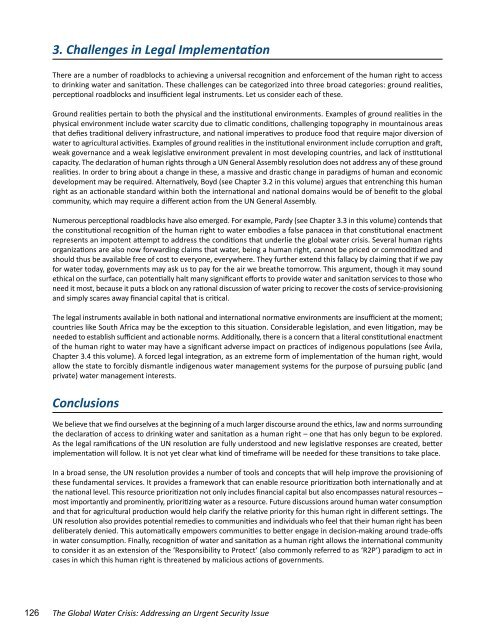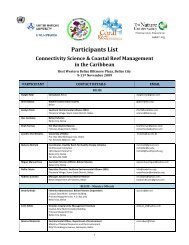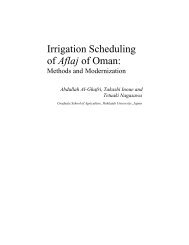The Global Water Crisis: Addressing an Urgent Security - Unu-inweh ...
The Global Water Crisis: Addressing an Urgent Security - Unu-inweh ...
The Global Water Crisis: Addressing an Urgent Security - Unu-inweh ...
You also want an ePaper? Increase the reach of your titles
YUMPU automatically turns print PDFs into web optimized ePapers that Google loves.
3. Challenges in Legal Implementation<br />
<strong>The</strong>re are a number of roadblocks to achieving a universal recognition <strong>an</strong>d enforcement of the hum<strong>an</strong> right to access<br />
to drinking water <strong>an</strong>d s<strong>an</strong>itation. <strong>The</strong>se challenges c<strong>an</strong> be categorized into three broad categories: ground realities,<br />
perceptional roadblocks <strong>an</strong>d insufficient legal instruments. Let us consider each of these.<br />
Ground realities pertain to both the physical <strong>an</strong>d the institutional environments. Examples of ground realities in the<br />
physical environment include water scarcity due to climatic conditions, challenging topography in mountainous areas<br />
that defies traditional delivery infrastructure, <strong>an</strong>d national imperatives to produce food that require major diversion of<br />
water to agricultural activities. Examples of ground realities in the institutional environment include corruption <strong>an</strong>d graft,<br />
weak govern<strong>an</strong>ce <strong>an</strong>d a weak legislative environment prevalent in most developing countries, <strong>an</strong>d lack of institutional<br />
capacity. <strong>The</strong> declaration of hum<strong>an</strong> rights through a UN General Assembly resolution does not address <strong>an</strong>y of these ground<br />
realities. In order to bring about a ch<strong>an</strong>ge in these, a massive <strong>an</strong>d drastic ch<strong>an</strong>ge in paradigms of hum<strong>an</strong> <strong>an</strong>d economic<br />
development may be required. Alternatively, Boyd (see Chapter 3.2 in this volume) argues that entrenching this hum<strong>an</strong><br />
right as <strong>an</strong> actionable st<strong>an</strong>dard within both the international <strong>an</strong>d national domains would be of benefit to the global<br />
community, which may require a different action from the UN General Assembly.<br />
Numerous perceptional roadblocks have also emerged. For example, Pardy (see Chapter 3.3 in this volume) contends that<br />
the constitutional recognition of the hum<strong>an</strong> right to water embodies a false p<strong>an</strong>acea in that constitutional enactment<br />
represents <strong>an</strong> impotent attempt to address the conditions that underlie the global water crisis. Several hum<strong>an</strong> rights<br />
org<strong>an</strong>izations are also now forwarding claims that water, being a hum<strong>an</strong> right, c<strong>an</strong>not be priced or commoditized <strong>an</strong>d<br />
should thus be available free of cost to everyone, everywhere. <strong>The</strong>y further extend this fallacy by claiming that if we pay<br />
for water today, governments may ask us to pay for the air we breathe tomorrow. This argument, though it may sound<br />
ethical on the surface, c<strong>an</strong> potentially halt m<strong>an</strong>y signific<strong>an</strong>t efforts to provide water <strong>an</strong>d s<strong>an</strong>itation services to those who<br />
need it most, because it puts a block on <strong>an</strong>y rational discussion of water pricing to recover the costs of service-provisioning<br />
<strong>an</strong>d simply scares away fin<strong>an</strong>cial capital that is critical.<br />
<strong>The</strong> legal instruments available in both national <strong>an</strong>d international normative environments are insufficient at the moment;<br />
countries like South Africa may be the exception to this situation. Considerable legislation, <strong>an</strong>d even litigation, may be<br />
needed to establish sufficient <strong>an</strong>d actionable norms. Additionally, there is a concern that a literal constitutional enactment<br />
of the hum<strong>an</strong> right to water may have a signific<strong>an</strong>t adverse impact on practices of indigenous populations (see Ávila,<br />
Chapter 3.4 this volume). A forced legal integration, as <strong>an</strong> extreme form of implementation of the hum<strong>an</strong> right, would<br />
allow the state to forcibly dism<strong>an</strong>tle indigenous water m<strong>an</strong>agement systems for the purpose of pursuing public (<strong>an</strong>d<br />
private) water m<strong>an</strong>agement interests.<br />
Conclusions<br />
We believe that we find ourselves at the beginning of a much larger discourse around the ethics, law <strong>an</strong>d norms surrounding<br />
the declaration of access to drinking water <strong>an</strong>d s<strong>an</strong>itation as a hum<strong>an</strong> right – one that has only begun to be explored.<br />
As the legal ramifications of the UN resolution are fully understood <strong>an</strong>d new legislative responses are created, better<br />
implementation will follow. It is not yet clear what kind of timeframe will be needed for these tr<strong>an</strong>sitions to take place.<br />
In a broad sense, the UN resolution provides a number of tools <strong>an</strong>d concepts that will help improve the provisioning of<br />
these fundamental services. It provides a framework that c<strong>an</strong> enable resource prioritization both internationally <strong>an</strong>d at<br />
the national level. This resource prioritization not only includes fin<strong>an</strong>cial capital but also encompasses natural resources –<br />
most import<strong>an</strong>tly <strong>an</strong>d prominently, prioritizing water as a resource. Future discussions around hum<strong>an</strong> water consumption<br />
<strong>an</strong>d that for agricultural production would help clarify the relative priority for this hum<strong>an</strong> right in different settings. <strong>The</strong><br />
UN resolution also provides potential remedies to communities <strong>an</strong>d individuals who feel that their hum<strong>an</strong> right has been<br />
deliberately denied. This automatically empowers communities to better engage in decision-making around trade-offs<br />
in water consumption. Finally, recognition of water <strong>an</strong>d s<strong>an</strong>itation as a hum<strong>an</strong> right allows the international community<br />
to consider it as <strong>an</strong> extension of the ‘Responsibility to Protect’ (also commonly referred to as ‘R2P’) paradigm to act in<br />
cases in which this hum<strong>an</strong> right is threatened by malicious actions of governments.<br />
126 <strong>The</strong> <strong>Global</strong> <strong>Water</strong> <strong>Crisis</strong>: <strong>Addressing</strong> <strong>an</strong> <strong>Urgent</strong> <strong>Security</strong> Issue




